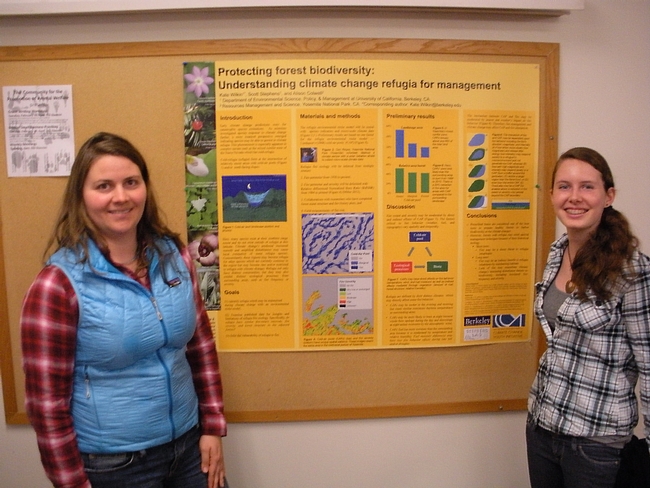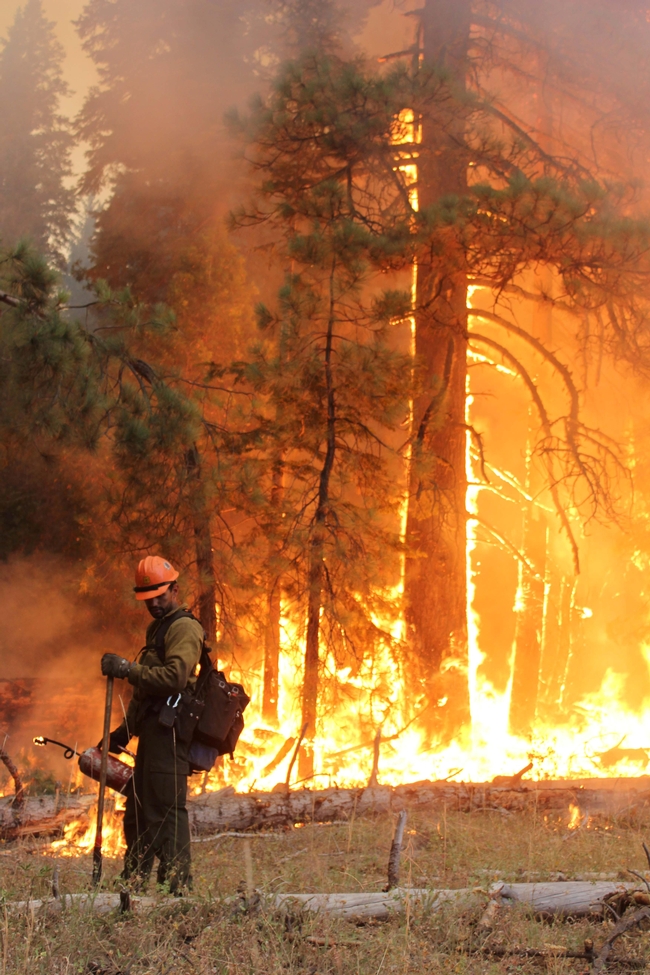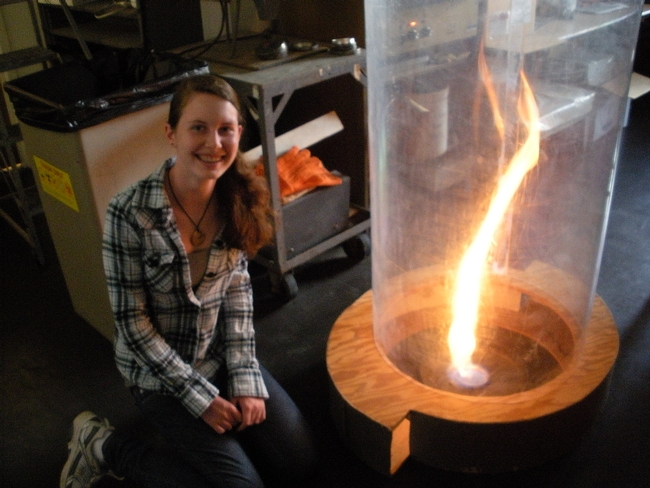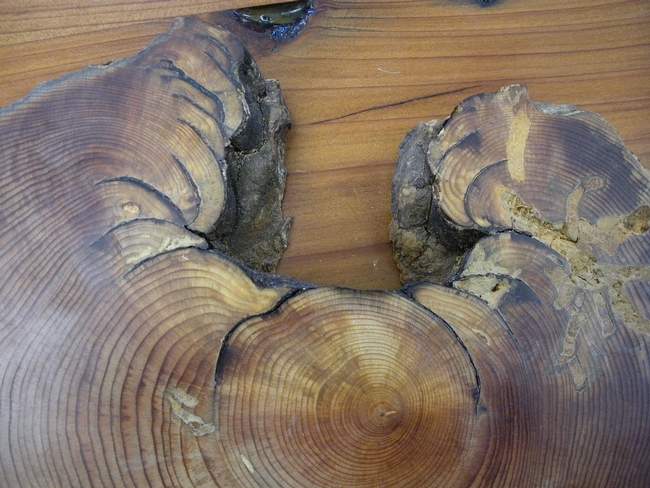Posts Tagged: Scott Stephens
The Rim Fire is a treasure trove of information for fire scientists
The key question, the story said, is what happened on Aug. 22 and 23, when a 200-foot wall of flames burned almost 90,000 acres.
"Almost half of this very, very large fire happened in just two days," said Max Moritz, UC Cooperative Extension specialist in the Department of Environmental Science, Policy and Management at UC Berkeley. "If you are a scientist, that is very interesting."
Leading up to the fire, Scott Stephens, professor in the Department of Environmental Science, Policy and Management at UC Berkeley, was in the area of the Rim Fire with a four-person research team measuring tree diameters and densities. They found as many as 400 trees per acre on the land, compared with 60 and 90 trees per acre in 1911. There was also between 30 and 40 tons of woody debris per acre on the forest floor, compared with 6 to 8 tons 92 years ago, Stephens said.
"We know the last fire in that area was in about 1905. That's 100 years without fire," Stephens said. "If you don't clear trees and brush and do some prescribed burning, you are eventually going to get a very closed forest that is very dense."
The U.S. Forest Service reported today, Sept. 3, that the Rim Fire is 70 percent contained.
Fire ecology - a ‘hot’ career to attract students to science
Ask most youth what they think about wildfires in forests and they will usually respond with "they kill trees and animals" or "it’s bad – they burn down homes and put out lots of smoke." They are partially right.
Ask youth about considering a career studying the history of fire from a tree cookie, a slice of tree branch that shows the rings, or lake bed sedimentation. Or ask them what role wind plays in how a fire jumps from treetop to treetop or how wildfire can help open pine cones and produce a huge flower show. Then they might respond with, "No way, is that a real job?"
Two eighth-grade students at Sutter Middle School in Sacramento got a chance to learn about fire ecology careers through a project in their science class requiring researching science careers. Students Maura Ingram and Jordan Johnston decided to explore fire ecology and learned that fire is a hot career choice.
Maura and Jordan interviewed Scott Stephens, professor in the Department of Environmental Science, Policy and Management at UC Berkeley*, about fire ecology careers. They learned that fire ecology as a discipline focuses on the origins of wildland fire and its relationship to the environment, both living and non-living. Fire ecologists recognize that fire is a natural and important process in the forested ecosystem, one that both animals and plants depend on.
“Some fire ecologists will be fire managers working with the U.S. Forest Service, National Park Service or private companies and will ignite and manage prescribed fires and manage wildfires,” Stephens said. “Other fire ecologists with jobs like mine will do research and write papers as teachers and university faculty. That will help guide fire managers in their work. More people are getting interested in fire ecology and the field has really grown in the last 15 years."
"Fire effects the forested landscape, by shaping the patterns of vegetation growth and mortality, recycles nutrients and changes the foraging and reproductive habitat for wildlife,” Stephens continued. “Fire is a critical part of most ecosystems in California and not allowing it to operate is causing great harm. We can do some operations with mechanical thinning and other methods to duplicate some aspects of fire, but not all of them.”
Anu Kramer and Kate Wilkin, UC Berkeley graduate students in the Stephens Fire Lab, showed Maura some of the tools they use in fire ecology research, such as lidar, computer fire models and the fire vortex used to demonstrate fire physics and extreme fire behavior.
“Extreme fire can create its own weather patterns including the creation and collapse of a fire column which can be very dangerous,” said Anu. “The fire vortex helps us visualize this on a small scale for our research.”
UC Berkeley students and researchers are working to understand how warming and precipitation changes due to climate change will affect fire frequency and behavior, and how fire disturbances affect plants by conducting scientific research and providing training in the fields of wildland fire science, ecology, and resource management. Students and researchers participate in interdisciplinary efforts when possible and share findings by publishing results in peer reviewed academic journals, posters for academic conferences, and conducting outreach to schools. Berkeley provides high quality scientific training and guidance for graduate students that will prepare them for careers in academia or professional fire science, policy or management.
“When you think about fire-related careers, most kids think that firefighters are the only ones that deal with fire directly,” said Maura. “But the career opportunities are endless. I have learned a lot about how important fire is. Fires can still cause a lot of damage to the forest and homes, but studying fire ecology is helpful because we can then use the data to apply fire in a more beneficial way – ways that help the forest, wildlife and the overall environment."
Stephens is one of the principle investigators of the Sierra Nevada Adaptive Management Project (SNAMP). SNAMP is investigating how fuels thinning projects effects fire behavior and forest health, water quality and quantity, and wildlife.

Kate Wilkins and Maura at the Stephens Fire Lab. (Photo: Kim Ingram)
Scientists study the history of prescribed burns
Long before Europeans first set foot in the New World, Native Americans were altering the California landscape by setting fires, UC Berkeley researchers believe. A multidisciplinary team of scientists is looking at a variety of evidence to better understand the nature of Native American prescribed burns. The team includes ANR fire science professor Scott Stephens.
The study was described in the UC Berkeley College of Letters and Science newsletter ScienceMatters@Berkeley. The article said burning could have helped indigenous Californians in many ways.
"If you're a hunter-gatherer living off the land, burning allows you a lot more choice, especially if there's a period of drought or a particularly wet year," the story quoted Kent Lightfoot, an anthropology professor directing the project.
The research includes the study of soil cores to:
- Identify plant species via the shapes of pollen
- Determine the amount of charcoal in various layers
- Sift through the remains of seeds and nuts
- Recover grass phytoliths, rigid microscopic bodies that occur in many plants
The study is being conducted in an area thought to be the site of an ancient settlement of Amah Mutsun Ohlone Native Americans, the article said. Striplen himself is of Amah Mutsun descent and is serving as a liaison between the scientists and the tribe.

Kent Lightfoot and graduate students Liam Reidy and Chuck Striplen at the research site.
FEMA changes course on wildfire hazards
Distribution of more than $5 million in federal funds for wildfire hazard abatement in the Oakland Hills has been delayed to allow time for a more intensive environmental impact review, according to an article in the Oakland Tribune.
The news was a setback for UC Berkeley, the city of Oakland and the East Bay Regional Park District, which are relying on the grants to remove eucalyptus, pine and acacia trees from steep, wooded canyons and ridges.
UC Berkeley fire science professor Scott Stephens told reporter Cecily Burt that the university's plans for reducing the fire hazard were "reasonable." He said that native trees and plants eventually take root in areas where eucalyptus are removed, and the proposed work plan leaves eucalyptus intact in less vulnerable areas.
"When the eucalyptus burn under an east wind, they can throw embers a half-mile or more," Stephens was quoted. "From a fire standpoint, what is being done to remove the eucalyptus is in line with what we want to do (to reduce fire hazards)."
A group called the "Hills Conservation Network" challenged the university's methods for reducing fire hazards by clear-cutting trees and leaving layers of wood chips on the ridges.
The delay, however, leaves the fire hazard unabated for another two years while FEMA studies the environmental impact of the plan.
"Inevitably we will get another east wind and we will have another disaster," Stephens was quoted in the story. "When you look at an area that has already been treated versus what hasn't, the risk is 10 percent greater. The physics haven't changed. We still have east winds, we have the topography, we have the trees. There will be a disaster."
UC Cooperative Extension has posted extensive information on wildfire hazard abatement on the Web.

A NASA photo of 1991 Oakland Hills fire.




